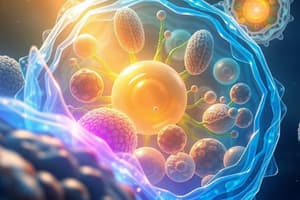Podcast
Questions and Answers
Which characteristic differentiates eukaryotic cells from prokaryotic cells?
Which characteristic differentiates eukaryotic cells from prokaryotic cells?
- Nucleus is membrane-bound (correct)
- Ability to divide by fission
- Size of cells
- Presence of ribosomes
What is the primary method of cell division in prokaryotic organisms?
What is the primary method of cell division in prokaryotic organisms?
- Mitosis
- Meiosis
- Budding
- Binary fission (correct)
Which of the following is a feature of eukaryotic cells?
Which of the following is a feature of eukaryotic cells?
- Unicellular only
- Presence of cytoskeleton (correct)
- Circular DNA
- 70S ribosomes
In what form is DNA packaged in eukaryotic cells?
In what form is DNA packaged in eukaryotic cells?
Which statement about the ribosomes in prokaryotic and eukaryotic cells is correct?
Which statement about the ribosomes in prokaryotic and eukaryotic cells is correct?
What is the primary function of mitochondria in a cell?
What is the primary function of mitochondria in a cell?
Which component of the cytoskeleton is primarily responsible for maintaining cell shape and organizing organelles?
Which component of the cytoskeleton is primarily responsible for maintaining cell shape and organizing organelles?
What role do lysosomes play in the cell?
What role do lysosomes play in the cell?
What structure functions as the storage area for various materials within a cell?
What structure functions as the storage area for various materials within a cell?
What is the function of vaults in the cell?
What is the function of vaults in the cell?
What is the primary function of the cell wall in plant cells?
What is the primary function of the cell wall in plant cells?
What are the main chemical components of the plant cell wall?
What are the main chemical components of the plant cell wall?
Which organelle is known as the control center of the cell?
Which organelle is known as the control center of the cell?
What distinguishes the rough endoplasmic reticulum from the smooth endoplasmic reticulum?
What distinguishes the rough endoplasmic reticulum from the smooth endoplasmic reticulum?
What is the primary role of the Golgi apparatus?
What is the primary role of the Golgi apparatus?
Which of the following correctly describes the plasma membrane?
Which of the following correctly describes the plasma membrane?
What is the function of plasmodesmata?
What is the function of plasmodesmata?
Which statement best describes the cytoplasm?
Which statement best describes the cytoplasm?
Flashcards are hidden until you start studying
Study Notes
The Cell Theory
- All organisms consist of cells; these are the smallest functional units of life.
- Every cell arises from pre-existing cells.
- Modern Cell Theory highlights that organism characteristics depend on individual cells and genetic continuity, with energy flow occurring within cells.
Prokaryotic vs. Eukaryotic Cells
- Prokaryotic cells average 1-2 micrometers in diameter; eukaryotic cells range from over 10-100 micrometers.
- Prokaryotes lack a nucleus and membrane-bound organelles, while eukaryotes possess both.
- Prokaryotic DNA is circular and naked, while eukaryotic DNA is packed in chromosomes, found in both unicellular and multicellular forms.
- Prokaryotes divide by fission; eukaryotes utilize mitosis and meiosis.
- Prokaryotes have 70S ribosomes, eukaryotes have 80S ribosomes.
- Examples of prokaryotes include bacteria and cyanobacteria; eukaryotes include plants, animals, fungi, algae, and protozoans.
Cell Wall
- Provides structural rigidity to plant cells and protects against bursting in hypotonic conditions.
- Composed of cellulose, pectin, and lignin.
Plasma Membrane
- Also called the cell or cytoplasmic membrane, characterized by fluidity according to the Fluid Mosaic Model.
- Regulates transport of molecules and serves as a site for specific enzymatic activity.
Plasmodesmata
- Small channels connecting the cytoplasm of neighboring plant cells, forming living bridges that facilitate communication and transport.
Cytoplasm
- Thick fluid, consisting of about 80% water, containing amino acids, lipids, carbohydrates, ions, and enzymes.
- The site for many chemical reactions and suspends organelles.
Nucleus
- Acts as the cell's control center, coordinating activities like growth, metabolism, protein synthesis, and cell division.
- Stores hereditary material (DNA); contains nucleolus for ribosome production and threadlike chromosomes.
Endoplasmic Reticulum (ER)
- Processes and transports a variety of biochemical compounds.
- Rough ER contains ribosomes and is the site of protein synthesis; Smooth ER lacks ribosomes and produces lipids and hormones.
Ribosomes
- Found in the cytoplasm (as free ribosomes) and on Rough ER.
- Responsible for protein synthesis and produced in the nucleolus.
Golgi Apparatus
- Known as the Golgi body or Golgi complex, present in both plant and animal cells.
- Composed of membrane-covered sacs called cisternae, functioning as the packaging and distribution center for the cell's chemical products.
Mitochondrion
- Double-membraned organelle and site of ATP synthesis through cellular respiration.
- Converts oxygen and nutrients into adenosine triphosphate (ATP) as the cell's power generator.
Cytoskeleton
- Comprises three types of fibers:
- Microtubules: Provide shape, facilitate protoplasmic streaming, and are building blocks of structures like cilia and flagella.
- Microfilaments: Offer strength under mechanical stress and assist in muscle contraction.
- Intermediate filaments: Maintain cell shape, organize organelles, and link cytoskeletal elements.
Lysosomes & Microbodies
- Lysosomes: The cell's "garbage system," containing enzymes for digestion of biomolecules and waste materials.
- Microbodies: Include peroxisomes for substance oxidation and glyoxisomes for fat-to-carbohydrate conversion.
Chloroplasts
- Organelles with photosynthetic functions containing chlorophyll pigment, crucial for capturing light energy.
Vacuoles
- Membrane-bound sacs filled with liquid, containing various materials including sugars and organic acids.
- Help maintain cell shape and serve space-filling functions as the cell grows.
Vaults
- Newly discovered organelles resembling octagonal barrels.
- Composed of cytoplasmic ribonucleoproteins, acting as cellular "trucks" to transport molecules from the nucleus to other parts of the cell, such as mRNA to ribosomes for protein synthesis.
Studying That Suits You
Use AI to generate personalized quizzes and flashcards to suit your learning preferences.



